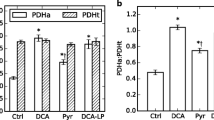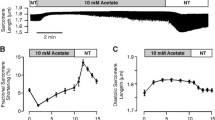Summary
The metabolism by coronary microvascular endothelial cells (CMEC) of the heart typical substrates palmitate and lactate was compared to that of glucose and glutamine. Confluent cultures of CMEC were used. Palmitate oxidation was saturable and independent of the exogenous albumin concentration. Palmitate, 300 μM, lactate, 1 mM, and glutamine, 0.5 mM, were oxidized to 35, 46, and 56 nmol CO2/h × mg protein. These oxidation rates were decreased by 80, 66, and 48% in presence of 5 mM glucose. The largest energy yield was obtained by glycolytic breakdown of glucose. Glucose, 5 mM, was degraded to lactate by 99%, and oxidized in the Krebs cycle by only 0.04%. 1% was catabolized via the hexose monophosphate pathway. The rate of glucose oxidation in the Krebs cycle could be 30-fold increased by the uncoupler 2,4-dinitrophenol, 30 µM. At concentrations lower than 1 mM the amount of glucose oxidized in the Krebs cycle also grew, indicating existence of the Crabtree effect. The energy demand of CMEC seems to be of the same order as that of the arrested heart.
Similar content being viewed by others
References
Piper HM, Probst I, Schwartz P, Hütter JF, Spieckermann PG: Culturing of calcium stable adult cardiac myocytes. J Mol Cell Cardiol 14: 397–412, 1982
Krützfeldt A, Spahr R, Mertens S, Siegmund B, Piper HM: Metabolism of exogenous substrates by coronary microvascular endothelial cells in culture. Submitted
Lowry OH, Rosebrough NJ, Farr AL, Randall RJ: Protein measurement with folin phenol reagent. J Biol Chem 193: 265–275, 1951
Jüngling E, Kammermeier H: Rapid assay of adenine nucleoties or creatine compounds in extracts of cardiac tissue by paired-ion reverse-phase high performance liquid chromatography. Anal Biochem 102: 358–361, 1980
Probst I, Spahr R, Piper HM: Carbohydrate and fatty acid metabolism of adult cardiac myocytes maintained in short-term culture. Am J Physiol 250: H853-H860, 1986
Dobrina A, Rossi F: Metabolic properties of freshly isolated bovine endothelial cells. Bioch Biophys Acta 762: 295–301, 1983
Wenner CE: Pasteur and Crabtree effects — assay in cells. Meth Enzymol 55: 289–297, 1979
Gonsalvez M, Garcia-Suarez S, Lopez-Alarcon L: Metabolic control of glycolysis in normal and tumor permeabilized cells. Cancer Res 38: 142–148, 1978
Chan CT, Brecher P, Haudenschild C, Chobanian CH: The effect of cholesterol feeding on the metabolism of rabbit cerebral microvessels. Microvasc Res 18: 353–369, 1979
Hingorani V, Brecher P: Glucose and fatty acid metabolism in normal and diabetic rabbit cerebral microvessels. Am J Physiol 252: E648-E653, 1987
Leighton B, Curi R, Hussein A, Newsholme EA: Maximum activities of some key enzymes of glycolysis, glutaminolysis, Krebs cycle and fatty acid utilization in bovine pulmonary endothelial cells. FEBS Lett 225: 93–96, 1987
Author information
Authors and Affiliations
Rights and permissions
About this article
Cite this article
Spahr, R., Krützfeldt, A., Mertens, S. et al. Fatty acids are not an important fuel for coronary microvascular endothelial cells. Mol Cell Biochem 88, 59–64 (1989). https://doi.org/10.1007/BF00223424
Accepted:
Issue Date:
DOI: https://doi.org/10.1007/BF00223424




